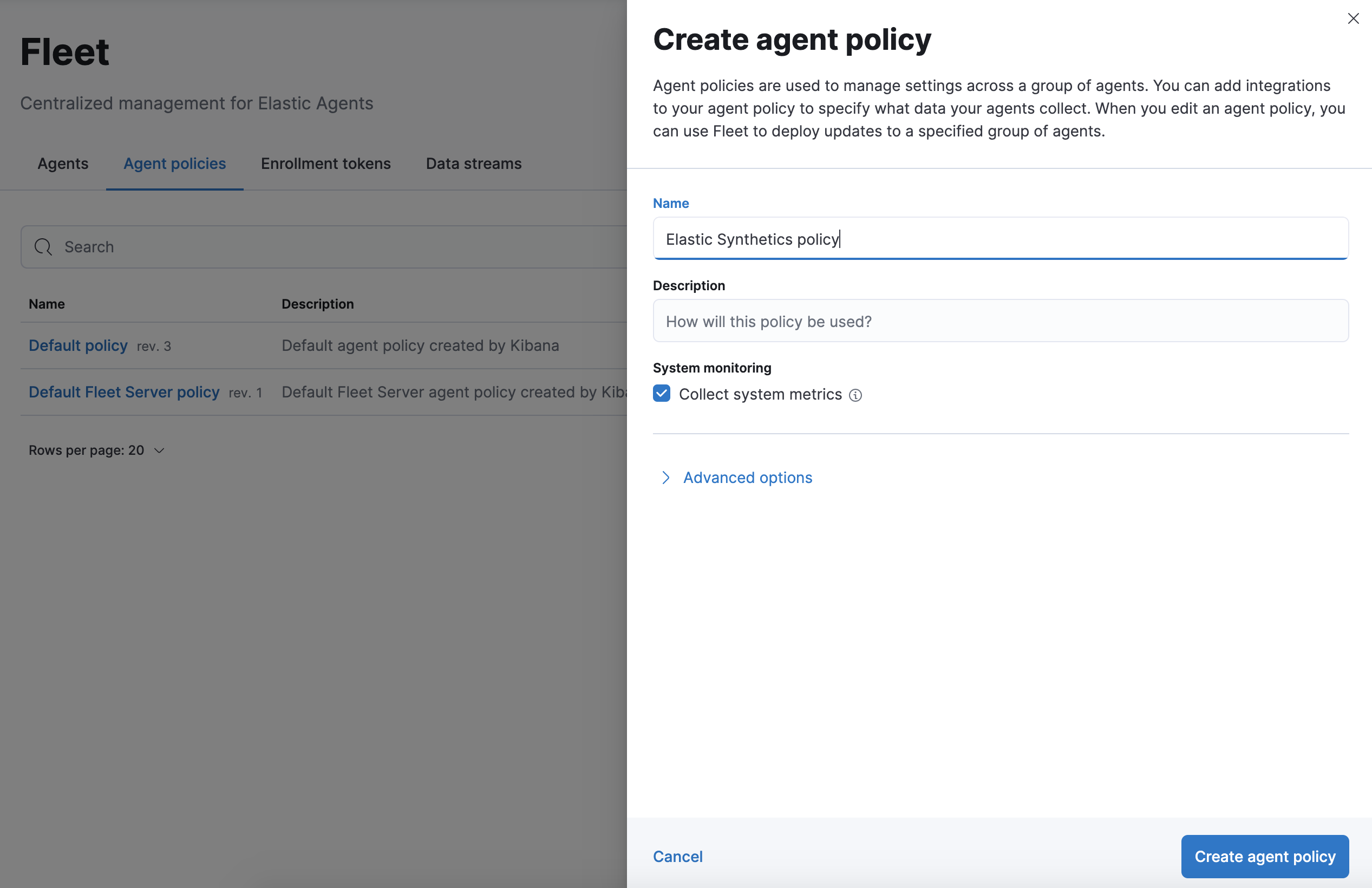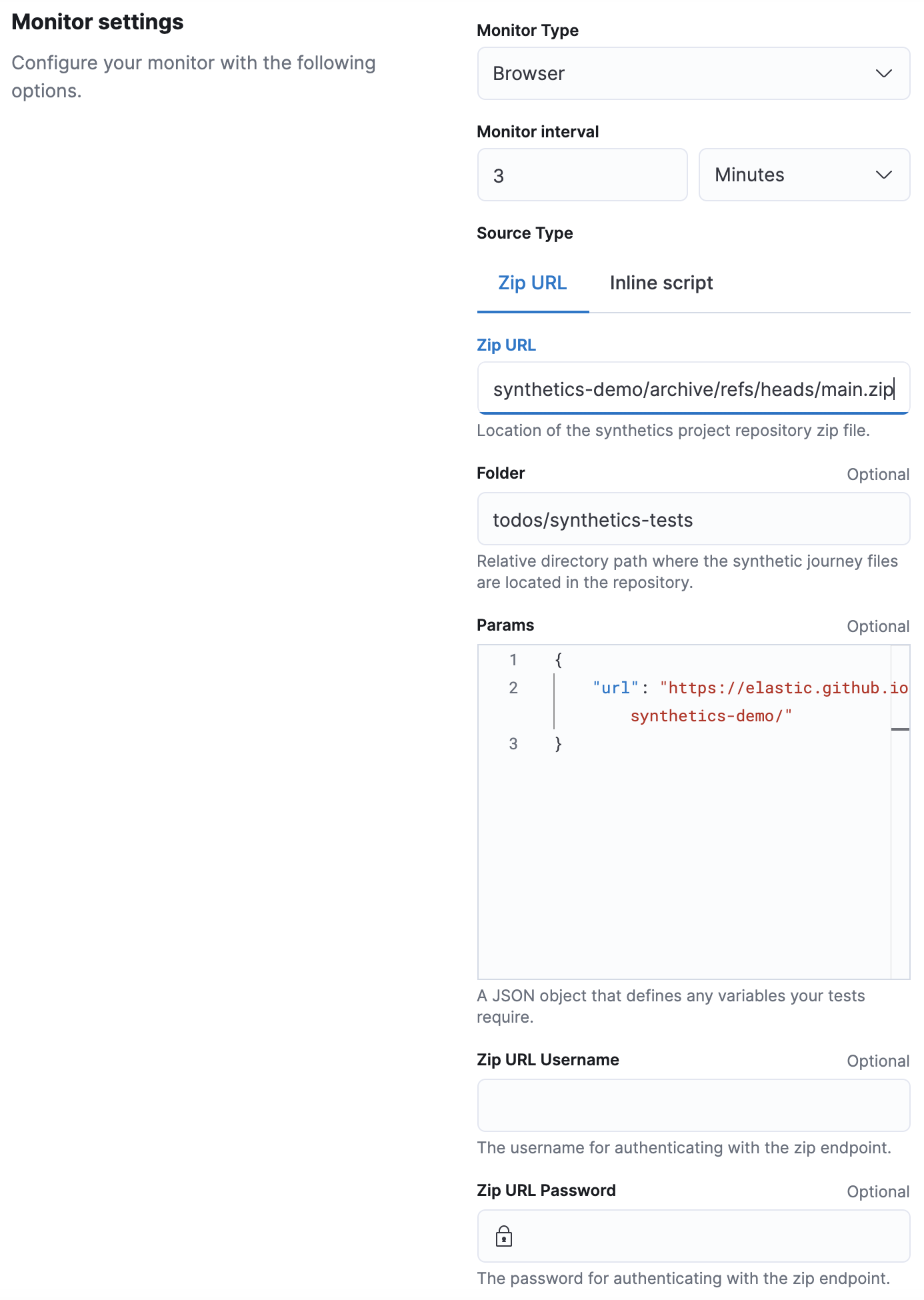Quickstart: Synthetic monitoring via Elastic Agent and Fleet
editQuickstart: Synthetic monitoring via Elastic Agent and Fleet
editSet up Fleet Server
editSynthetic monitoring via Elastic Agent and Fleet requires Fleet Server to be set up. If you are using Elastic Cloud fleet server will already be provided and you can skip this step. To learn more, see Fleet.
Create an agent policy for Elastic Synthetics
editUse a separate fleet policy for Synthetics monitors in most cases. It is generally the case that synthetics monitors should run on nodes dedicated to that purpose. See Elastic Agent policy for more information on Fleet policies and creating them.

Add an Elastic Agent to Fleet, using the special elastic-agent-complete container
editElastic Agent is a single, unified agent that you can deploy to hosts or containers to collect data and send it to the Elastic Stack. Behind the scenes, Elastic Agent runs Beats or Elastic Endpoint required for your configuration.
To run synthetics tests, you must use the elastic-agent-complete Docker image to create a self-hosted Elastic Agent node. This image contains the dependencies to run synthetic monitors. The standard Elastic Cloud or self-hosted Elastic Agent will not work.
To add an Elastic Agent to Fleet, you’ll need an enrollment token and the URL of your fleet server. You can use the default enrollment token for your policy or create new enrollment tokens as needed. To learn more, see Run Elastic Elastic Agent in a container and Fleet enrollment tokens for more information. Please note that you must run the docker container as a non-root user for Browser monitors. See Note on Sandboxing and Security for more information on security requirements and compatibility within the container.
You may need to set additional environment variables. See the Elastic Agent environment variables guide for more information. See Run Elastic Agent in a container for more information on running Elastic Agent with Docker.
Configure an Elastic Synthetics integration policy
edit[beta] This functionality is in beta and is subject to change. The design and code is less mature than official GA features and is being provided as-is with no warranties. Beta features are not subject to the support SLA of official GA features. Elastic Synthetics tests can be configured through Fleet using the Elastic Synthetics integration. To learn more, see Elastic Synthetics.

In the example above, our library of synthetic tests is downloaded from the remote zip endpoint for our todos example. The fields should be set as follows:
- Zip URL: URL pointing to a zip file containing the test project.
- Folder: The folder within the zip file containing synthetics tests, this will be the working directory in which the synthetics agent will be run. Heartbeat will invoke the synthetics library in this folder.
- Zip URL Username and Zip URL Password HTTP Basic Authentication headers for the remote zip endpoint.
- Params JSON formatted dynamic values that may be required by your specific tests. See Working with parameters and secrets for more information.
When applying the integration policy to an Elastic Agent policy, make sure to select your dedicated synthetics agent policy.

View in Kibana
editThat’s it! Elastic synthetics is now sending synthetic monitoring data to the Elastic Stack. Navigate to the Uptime app in Kibana, where you can see screenshots of each run, set up alerts in case of test failures, and more.
If a test does fail (shown as down in the app), you’ll be able to view the step script that failed,
any errors, and a stack trace.
See Visualize for more information.
Note on Sandboxing and Security
editSynthetics Browser checks can only run as the non-root elastic-agent user in the elastic-agent container. Synthetics ICMP checks, on the other hand, require running as the root user. We are currently working to simplify the permissions requirements to work with a single user. This can be tracked in this github issue.
Elastic synthetics runs Chromium without the extra protection of its process sandbox for greater compatibility with Linux server distributions. This is generally safe when run against sites whose content you trust when using a recent version of Elastic Synthetics and Chromium. A malicious site could leverage a sandbox escape which could lead to a compromise of the Elastic Agent container running synthetics, and any sensitive data within.